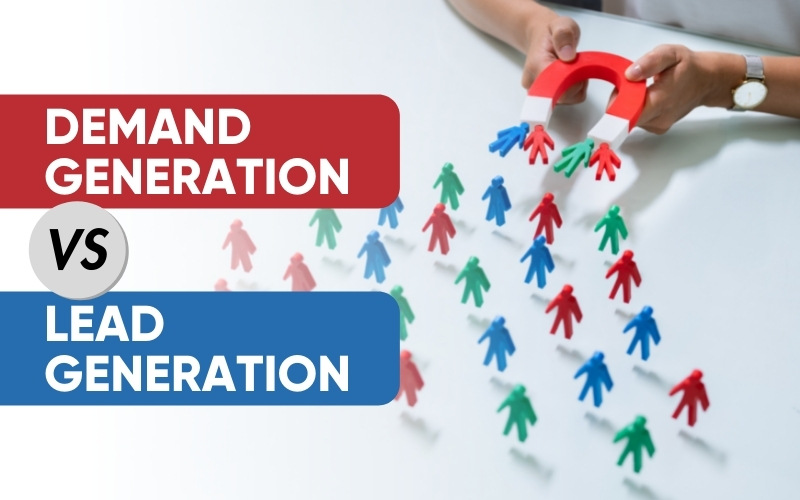If you’ve heard the terms, “demand generation” and “lead generation”, you might think they sound similar; however, they have two completely separate meanings that are not interchangeable. With the numerous new coined words added to the marketing world dictionary, you might want to know what both of these words mean as well as the major functions, as well as the differences, between demand generation vs. lead generation. lead
The pair of terms are involved in the intricate tango that is digital marketing. Demand generation creates buyers’ desire for something, while lead generation hones in on that desire. More than just the freshest buzzwords on the internet-savvy B2B scene, let’s dig into definitions and differences between demand generation and lead generation.
What is a Sales Funnel?

Before diving in, it is essential to understand what a sales funnel is. The sales funnel consists of different steps in the customer’s process of learning and buying from you. It comes in varying stages which serve as the customer’s “life cycle” with your product, except that it can repeat with loyal customers.
Stages of the Sales Funnel
- Attention: The start of the process mandates that you grab the customer’s attention. Help answer the question in their minds: why are you a unique and essential addition to their lives? Here you offer value to your customer either through providing important information, or a free consultation.
- Interest: After the initial interaction with your product your possible customer becomes interested in your company. What do you have to offer? What are the intricacies: pricing, features, etc.? Offer them something they need like solutions to their problems or better results than other products/services.
- Desire: They know about you now. You are more than just a name; you come with markers of what your brand is. What makes you stand out? Make this clear to your customer through customer reviews, behind-the-scenes videos, or sneak peeks.
- Action: You have them in the palm of your hand. All they need to do is buy your product or avail of your services.
- Evaluation: You don’t want to stop at a one-time purchase. If your product or service is truly high-quality or your customer service was very helpful, your customers will loyally recommend your brand to others. In some cases, they become repeat customers! Stamp cards, extra discounts for loyalty, and other perks can keep them coming back.
The sales funnel sounds smooth sailing at this point but, in reality, it can sometimes paint a different picture. Demand generation and lead generation serve different stages of the sales funnel and are both equally important.
What is Demand Generation?
Demand generation or “demand gen” is a digital marketing strategy that creates an awareness and demand for your business’ service or product. In other words, demand generation introduces your brand to your target audience. Attracting traffic to your website is an integral step and the first part of the sales funnel. After successful demand generation, you can count on a trusting, interested group of customers at your disposal, ready to be led into closing the deal.
Strategies that can be considered as demand generation include:
- YouTube videos
- Facebook, Twitter, or Instagram posts
- Infographics
- Resource pages
- Podcasts
- Slideshows
- Press releases
- Case studies
Future customers still do not give their personal information in exchange for any of these resources. They are just free to roam through your website, trying out different aspects.
What is Lead Generation?

In contrast, lead generation is a digital marketing strategy that does entail asking for information such as the customer’s email address, age, sex, and other pertinent information that could end with a sale. This is also referred to as “lead gen”.
While creating website content such as blog posts can still be considered part of lead generation, there is more emphasis on retrieving the aforementioned details. Lead gen contributes to the later steps of the sales funnel. The strategies involved here, after all, feed into the cycle of knowing more about the customer and thus fulfilling their needs, getting leads, increasing sales which are all needed to attract and get to know the customer.
Strategies that many uses for lead generation include:
- Content in exchange for knowledge about customer profiles
- Ebooks
- Webinars
- Chatbots
- White papers and reports
- Live events
These kinds of strategies ask for more time and effort on the part of customers. This means they more often already know about the brand as part of the demand gen. Lead gen allows them to dip their toes in the pool and see what it’s like to purchase from the company. Oftentimes these activities can be direct and meaningful situations for customers, roping them into buying or availing of a product or service.
Final Thoughts
Demand generation and lead generation back up different parts of the sales funnel, attracting and leading possible customers to the purchase. They might sound the same; however, demand generation is a customer-voluntary tactic while lead generation can be a little more hands-on. Overall, both play key roles in getting that sale and hopefully forging a long-term relationship with a broad group of satisfied and engaged customers.




